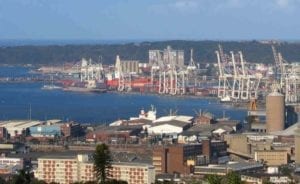Cargo owners using the Durban port can score big if they choose their warehousing partner wisely, discovers Tristan Wiggill.
There are numerous advantages to using a customs-controlled or bonded warehouse in the Durban port, as goods can be cleared at the warehouse directly, which speeds up the import/export process. Bonded facilities are also more cost-effective. A short- to medium-term solution, current legislation in South Africa dictates that goods remain in bonded warehouses for no longer than two years. Greystone Enterprises operates a storage facility inside the Durban port and has five others spread throughout the country. “Our export business has been quiet for the last nine to ten months, due to depressed commodity prices and lower demand, especially of steel from our largest export destination, China,” indicates warehouse manager Jeff Stone. “Import volumes have also been lower than usual, although the demand has been more constant,” he says. His company primarily imports animal feed, which it supplies to pet food companies like Epol. Stone’s Durban facility, like those of his competitor’s, operates 24/7, which creates as much additional work as additional labour costs. Warehouses in the Durban port are given just three days to collect and stack their cargo. Failure to do so results in fines, demurrage fees or the short-shipping of loads. As frequently reported, congestion is a significant problem in the port of Durban, which is particularly evident on the access road leading into the port. As is the case in the ports of Port Elizabeth and Ngqura, high winds cause regular disruptions. Wind speeds over 80 km/h stop the multimillion-rand ZPMC cranes from working. When this happens, Transnet Port Terminals (TPT) has to make allowances and adjust ship-loading dates. Despite the congestion in the port of Durban, it is still advantageous to have a warehouse inside the port, due to the proximity to the action. Being so close means a reduced need for transportation; the most costly leg in any logistics operation. “Most clients are cargo owners, manufacturers and producers but, as a warehouse and storage facility, we also interact with freight forwarders and freight brokers,” clarifies Stone.Given the proximity advantages, there is tremendous competition in the port in terms of warehousing space. Companies with the lowest overhead costs frequently emerge as preferred partners, simply due to their ability to lower storage costs, which is the leading consideration for most cargo owners.
Although South Africa’s port efficiency is in line with African ports on average, it is far below other main ports around the world, with the Durban port performing poorly in several categories. The average turnaround time per TEU handled in Durban is 1.7 days per 1 000 TEUs, which is three times higher than large ports such as Long Beach; Hong Kong SAR, China; New York and Antwerp. Crane performance has remained relatively constant at around 20 moves per hour per crane, which is well below international standards of 35 to 40 moves per crane per hour. Truck turnaround time is targeted to be around 35 minutes, while evidence underlines that it is usually above 60 minutes at the Durban Container Terminal. In addition, because very few of the containers moving through Durban are transported by train (around 15%), it causes substantial congestion around the port area. This is amplified by constraints on land availability for container stacking, congestion at the port gate and terminal inefficiencies that have led to increased ship waiting times. According to the World Bank’s ‘Supporting Export Competitiveness through Port and Rail Network Reforms’ policy research working paper, the solution to the congestion does not rely solely with the ports authorities. Practices of the private sector, including lack of coordination and inefficient dispatch practices, contribute to congestion in and around the port.







